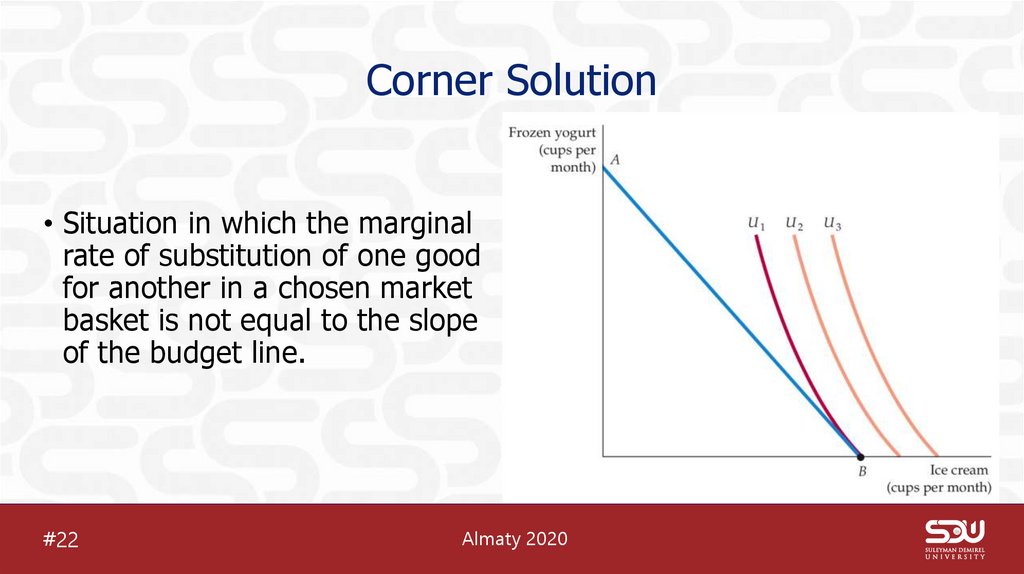Similar presentations:
Consumer Behavior
1. Consumer Behavior
3th chapter2. How consumer with a limited income decide which G&S to buy?
How consumer with a limited income decidewhich G&S to buy?
-Consumer Preferences (dream)
-Budget Constraints (prices)
- Consumer choices (price & preference)
3. Consumer Preferences
Market Basket – units of specific commodities (bundle)Food versus Clothing
Market basket
Units of Food
Units of Clothing
A
20
30
B
10
50
D
40
20
E
30
40
G
10
20
H
10
40
#01
Almaty 2020
4. 3 assumptions of Consumer Preferences
1) Completeness (equally prefer A to B or B to A)2) Transitivity (Prefer A to B, B to C)
3) More is better than less
#02
Almaty 2020
5. Indifference Curve
#03Almaty 2020
6. Indifference Maps
#04Almaty 2020
7. Indifference Curves cannot intersect
#05Almaty 2020
8. The Shape of Indifference Curve
#06Almaty 2020
9. Marginal Rate of Substitution
MRS is amount of a good that consumer is willing to give up in order toobtain one additional unit of another good
MRS = 3 (means he will give up 3 units of clothes to obtain 1 food)
MRS = “-” delta C/ delta F (MRS IS ALWAYS POSITIVE)
#07
Almaty 2020
10. 4th assumption of Consumer Preferences
Diminishing marginal rate ofsubstitution
Indifference curves are convex
As Food consumption increases,
Additional
satisfaction
from
consumption of Food will decrease
#08
Almaty 2020
11. Perfect Substitutes & Perfect Complements
Perfect Substitutes & Perfect ComplementsGenerally, more is
preferred to less.
But in some cases,
things like air
pollution preferred
less to more.
#09
Almaty 2020
12. Utility
1) Numerical Score representing the satisfaction that a consumergets from a given market basket.
2) Utility Function is the formula that assigns level of satisfaction of
the consumer to each market basket.
U (F, C) = F+2C
U(F,C)= F*C=2,5*10=25;(D)
If basket A consists of 8F & 3C => U(F,C)=8+2*(3)=14
If basket B consists of 4F & 4C => U(F,C)=4+2*(4)=12
If basket D consists of 4C & 4F => U(F,C)=4+2*(4)=12
He would prefer A than D and B, cause more is better than less
#10
Almaty 2020
13. Utility Functions & Indifference Curves U(F,C)= F*C=5*5=25;(A) =2,5*10=25(D) =10*2,5=25(B)
Utility Functions & Indifference CurvesU(F,C)= F*C=5*5=25;(A)
=2,5*10=25(D)
=10*2,5=25(B)
#11
Almaty 2020
14. Ordinal & Cardinal Utility
Ordinal & Cardinal Utility• Ordinal Utility is a function that generates a ranking of market
baskets in order of most to least preferred.
• Cardinal Utility is a function describing by how much one market
basket is preferred to another.
#12
Almaty 2020
15. Budget Constraints & Budget Line
Budget Constraints & Budget Line• Constraints that consumers face as a result of limited incomes.
• Ex: Women fixed income (I), that could be spent on Food (F) &
Clothes (C), Price of C (Pc) & Price of F (Pf).
• Budget Line indicates all combinations of F & C for which the total
amount of money spent is equal to income.
#13
Almaty 2020
16. Market Basket & Budget Line
Market Basket & Budget Line#14
Almaty 2020
17. Market Basket & Budget Line
Market Basket & Budget Line#15
Almaty 2020
18. The Effects of Changes in Income
#16Almaty 2020
19. The Effects of Changes in Prices
#17Almaty 2020
20. Conclusion for budget line
• When the income of consumer changes budget line shifts andslope of the budget line doesn’t change.
• When the price of one good changes, budget line rotates
inward or outward, and slope of the budget line changes.
21. Consumer Choice
• We assume that• Consumers choose good in rational way & ”to maximize the
satisfaction they can achieve, given the limited budget available".
• #1 condition: Utility must be located on the budget line
• #2 condition: It must give the consumer the most preferred
combination of G&S.
#18
Almaty 2020
22. Maximizing Consumer Satisfaction
#19Almaty 2020
23. Maximizing Consumer Satisfaction
MRS = Pf/PcSatisfaction is maximized when the marginal rate of substitution (of
F for C) is equal to the ratio of the prices (of F to C).
marginal benefit Benefit from the consumption of one additional
unit of a good. (MRS, Slope of indifference curve)
marginal cost Cost of one additional unit of a good. (slope of
budget line, ratio of prices)
#20
Almaty 2020
24. Maximizing Consumer Satisfaction
Marginal Benefit = MRS = ½at point A (slope of
indifference curve)
Marginal Cost =Pf/Pc=1/2 at
point A (Slope of budget line)
Marginal Cost=Marginal
Benefit= Max.Satisfaction
#21
Almaty 2020
25. Corner Solution
• Situation in which the marginalrate of substitution of one good
for another in a chosen market
basket is not equal to the slope
of the budget line.
#22
Almaty 2020
26. Marginal Utility & Consumer Choice
Marginal Utility & Consumer ChoiceM.U. measures the additional utility obtained from consuming one
additional unit of a good.
As consumption increases => Marginal utility will decrease
0=MUf(△F)+MUc(△C)
-(△C/△F)=MUf/MUc
⇩
MRS = MUf/Muc
MRS = Pf/Pc, so => MUf/Pf=MUc/Pc
#23
Almaty 2020
27. Ideal Cost of Living Indexes
Cost of attaining a given level of utility at current pricesrelative to the cost of attaining the same utility at baseyear prices.
#24
Almaty 2020
28.
• Ideal Cost of living adjustment=$1260-$500=$760• Ideal cost of living index=$1260/$500=2,52*100%=252%
• 2000 100%
• 2010 252%
• 252%-100%=152%
29. Ideal Cost of Living Indexes
#25Almaty 2020
30. Laspeyres Index & Paasche Index
Laspeyres Index & Paasche IndexLaspeyres price index
Amount of money at current year prices that an
individual requires to purchase a bundle of goods and
services chosen in a base year divided by the cost of
purchasing the same bundle at base-year prices.
Paasche index
money at current-year prices that an individual requires
to purchase a current bundle of goods and services
divided by the cost of purchasing the same bundle in a
base year.
#23
Almaty 2020
31. Laspeyres Index
• $20*15+$2,00*100=$500(2000year)Sarah• $100*15+$2,20*100=1500+220=$1720(2010 years)Rachel
• Laspeyres adjustment= $1720-$500=$1220
• Laspeyres index= 1720/500=3,44
• 3,44*100=344%-100%=244%
• Consumption is 2000’s consumption
• Chain-Weighted Index
• Paasche index
32. Thanks for attention
1/1 Abylaikhan str., Kaskelen040900 Almaty, Kazakhstan
+7 727 307 95 65
































 management
management





